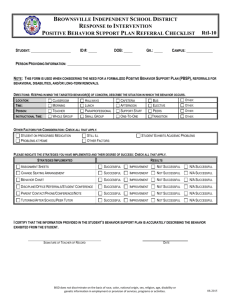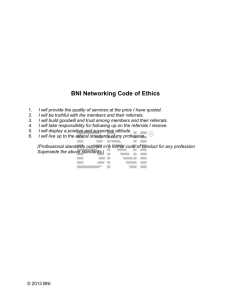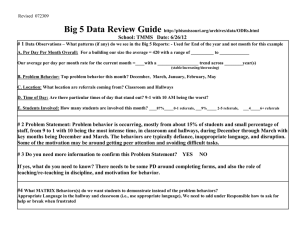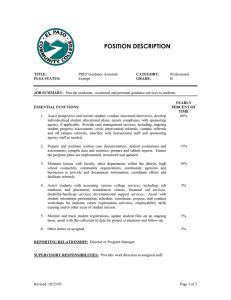Using Information for Decision Making Identifying Interventions that support Targeted and Intensive Students
advertisement
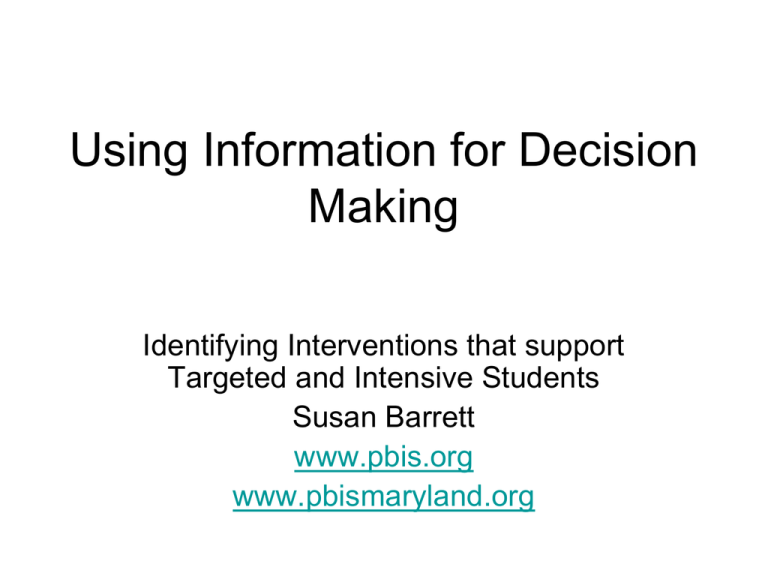
Using Information for Decision Making Identifying Interventions that support Targeted and Intensive Students Susan Barrett www.pbis.org www.pbismaryland.org Monitor Objectives & Outcomes • Big Idea: – The staff determine what they want to answer, what data will answer the question, the simplest way to get that data, and then write an objective for where they want to be in the future. Questions How does the team use to data to: • Get 80% staff buy-in (staff survey, TIC) • Keep 80% buy-in (BIG 5, communication) • for problem solving across all teams/committees • Utililize the three-tiered model of prevention (integrate student services, academic support, teacher support) Positive Behavior Support Supporting Staff Behavior INFORMATION Supporting Decision Making School wide Non classroom Classroom office discipline referrals PBS self assessment survey all staff (parents/students?) input academic progress attendance direct observation Individual students school improvement goal progress SYSTEMS PRACTICES Supporting Student Behavior define (behav. expect. & routines) teach acknowledge correct follow up & feedback consensus & collaboration Why Collect Discipline Information? • Decision making • Professional Accountability • Decisions made with data (information) are more likely to be (a) implemented, and (b) effective Key features of data systems that work. • The data are accurate • The data are very easy to collect (1% of staff time) • Data are used for decision-making – The data must be available when decisions need to be made (weekly?) – Difference between data needs at a school building versus data needs for a district – The people who collect the data must see the information used for decision-making. What data to collect for decisionmaking? • USE WHAT YOU HAVE – Office Discipline Referrals/Detentions • Measure of overall environment. Referrals are affected by (a) student behavior, (b) staff behavior, (c) administrative context • An under-estimate of what is really happening • Office Referrals per Day per Month – Attendance – Suspensions/Expulsions – Vandalism Office Discipline Referral Processes/Form • Coherent system in place to collect office discipline referral data – Faculty and staff agree on categories – Faculty and staff agree on process – Office Discipline Referral Form includes needed information • • • • Name, date, time Staff Problem Behavior, maintaining function Location Observe Problem Behavior Warning/Conference with Student No Use Classroom Consequence Complete Minor Incident Report Does student have 3 MIR slips for the same behavior in the same quarter Write the student a REFERRAL to the main office Is behavior office managed? Yes Classroom Managed Office Managed •Preparedness •Calling Out •Classroom Disruption •Refusal to Follow a Reasonable Request (Insubordination) •Failure to Serve a Detention •Put Downs •Refusing to Work •Inappropriate Tone/Attitude •Electronic Devices •Inappropriate Comments •Food or Drink •Weapons •Fighting or Aggressive Physical Contact •Chronic Minor Infractions •Aggressive Language •Threats •Harassment of Student or Teacher •Truancy/Cut Class •Smoking •Vandalism •Alcohol •Drugs •Gambling •Dress Code •Cheating •Not w/ Class During Emergency •Leaving School Grounds •Foul Language at Student/Staff Write referral to office Administrator determines consequence Administrator follows through on consequence Administrator provides teacher feedback SIDE BAR on Minor Incident Reports •Issue slip when student does not respond to pre-correction, re-direction, or verbal warning •Once written, file a copy with administrator •Take concrete action to correct behavior (i.e. assign detention, complete behavior reflection writing, seat change) Minor Incident Reports • Overall Design – Smaller than referral – In triplicate – Replaced Detention Forms • Pre-Referral Documented Step • Flexible Consequences – Ex: Detention, reflection, parent signature, etc. • Administrative Intervention Before Referral When Should Data be Collected? • Continuously • Data collection should be an embedded part of the school cycle not something “extra” • Data should be summarized prior to meetings of decision-makers (e.g. weekly) • Data will be inaccurate and irrelevant unless the people who collect and summarize it see the data used for decision-making. Organizing Data for “Information” • Counts are good, but not always useful • To compare across months use “average office discipline referrals per day per month” Total Ref versus Ref/Day/Mo NV High School 70 R e fe rra ls 60 50 40 30 20 10 0 Aug Sept Oct Nov Dec Jan Feb Mar School Month Apr May Jun M e a n R e fe rr a ls p e r D a y Total Ref versus Ref/Day/Mo 5 4 3 2 1 0 Aug Sept Oct Nov Dec Jan Feb School Month Mar Apr May Jun Using Data for On-Going Problem Solving • Start with the decisions not the data • Use data in “decision layers” – Is there a problem? (overall rate of ODR) – Localize the problem – (location, problem behavior, students, time of day) – Get specific • Don’t drown in the data • It’s “OK” to be doing well • Be efficient Is there a problem? • Office Referrals per Day per Month • Attendance • Faculty Reports Interpreting Office Referral Data: Is there a problem? • Absolute level (depending on size of school) – Middle Schools (>5 per day) – Elementary Schools (>1.5-2 per day) • Trends – Peaks before breaks? – Gradual increasing trend across year? • Compare levels to last year – Improvement? A v e R e fe rra ls p e r D a y Office Referrals per Day per Month Last year 2 1.5 1 0.5 0 Sept Oct Nov Dec Jan Feb Mar School Months Apr May Jun A v e R e fe rra ls p e r D a y Office Referrals per Day per Month Last year 20 15 10 5 0 Sept Oct Nov Dec Jan Feb Mar School Months Apr May Jun A v e R e fe rra ls p e r D a y Office Referrals per Day per Month Last year 20 15 10 5 0 Sept Oct Nov Dec Jan Feb Mar School Months Apr May Jun A v e R e fe rra ls p e r D a y Office Referrals per Day per Month This Year 20 15 10 5 0 Sept Oct Nov Dec Jan Feb Mar School Months Apr May Jun A v e R e fe rra ls p e r D a y Office Referrals per Day per Month Last Year and This Year 20 15 10 5 0 Sept Oct Nov Dec Jan Feb Mar School Months Apr May Jun A v e R e fe rra ls p e r D a y Office Referrals per Day per Month Last Year and This Year 20 15 10 5 0 Sept Oct Nov Dec Jan Feb Mar School Months Apr May Jun Is There a Problem? #1 Maintain - Modify - Terminate A v e R e fe rra ls p e r D a y Office Referrals per Day per Month This Year 20 15 10 5 0 Sept Oct Nov Dec Jan Feb School Months Mar Apr May Is There a Problem? #4 Maintain - Modify - Terminate A v e R e fe rra ls p e r D a y Office Referrals per Day per Month Last Year and This Year 20 15 10 5 0 Sept Oct Nov Dec Jan Feb Mar School Months Apr May Jun What systems are problematic? • Referrals by problem behavior? – What problem behaviors are most common? • Referrals by location? – Are there specific problem locations? • Referrals by student? – Are there many students receiving referrals or only a small number of students with many referrals? • Referrals by time of day? – Are there specific times when problems occur? Referrals by Problem Behavior Referrals per Prob Behavior N u m b e r o f R e fe rra ls 50 40 30 20 10 0 Lang Achol Arson Bomb Combs Defian Disrupt Dress Agg/fgt Theft Harass Prop D Skip Tardy Types of Problem Behavior Tobac Vand Weap Referrals by Problem Behavior Referrals per Prob Behavior N u m b e r o f R e fe rra ls 50 40 30 20 10 0 Lang Achol Arson Bomb Combs Defian Disrupt Dress Agg/fgt Theft Harass Prop D Skip Tardy Types of Problem Behavior Tobac Vand Weap Referrals per Location N u m b e r o f O ffic e R e fe rra ls Referrals by Location 50 40 30 20 10 0 Bath R Bus A Bus Caf Clas s Comm Gym Hall Libr School Locations Play G Spec Other N u m b e r o f O ffic e R e fe rr a ls Referrals by Location 50 40 30 20 10 0 Bath R Bus A Bus Caf Class Comm Gym Hall Libr School Locations Play G Spec Other N u m b e r o f R e fe rra ls p e r S tu d e n t Referrals per Student 20 10 0 Students N u m b e r o f R e fe rra ls p e r S tu d e n t Referrals per Student Students per Number of Referrals 20 10 0 Students Referrals by Time of Day Referrals by Time of Day N u m b e r o f R e fe rra ls 30 25 20 15 10 5 0 7:00 7:30 8:00 8:30 9:00 9:30 10:00 10:30 11:00 11:30 12:00 12:30 Time of Day 1:00 1:30 2:00 2:30 3:00 3:30 Referrals by Time of Day Referrals by Time of Day N u m b e r o f R e fe rra ls 30 25 20 15 10 5 0 7:00 7:30 8:00 8:30 9:00 9:30 10:00 10:30 11:00 11:30 12:00 12:30 Time of Day 1:00 1:30 2:00 2:30 3:00 3:30 Decision-making • • • • Is there a problem? What areas/systems are involved? Are there many students or a few involved? What kinds of problem behaviors are occurring? • When are these behaviors most likely? • What is the most effective use of our resources to address this problem? Designing Solutions • If many students are making the same mistake it typically is the system that needs to change not the students. • Teach, monitor and reward before relying on punishment. • An example (Kartub et al, JPBI, 2000) IF... More than 40% of students receive one or more office referrals More than 2.5 office referrals per student More than 35% of office referrals come from nonclassroom settings More than 15% of students referred from nonclassroom settings More than 60% of office referrals come from the classroom 50% or more of office referrals come from less than 10% of classrooms More than 10-15 students receive 5 or more office referrals Less than 10 students with 10 or more office referrals Less than 10 students continue rate of referrals after receiving targeted group settings Small number of students destabilizing overall functioning of school FOCUS ON... School Wide System Non-Classroom System Classroom Systems Targeted Group Interventions / Classroom Systems Individual Student Systems Targeted Group Supports • For those students who exhibit difficulties despite proactive school-wide prevention efforts • Likely to be student with both academic & behavioral challenges • Approximately 10% of school population Remember… Without school-wide prevention, we cannot reliably identify targeted-level students. Halls Ferry Elementary School YEAR 1 YEAR 2 YEAR 3 YEAR 4 YEAR 5 High Five Approach - school wide social skill lessons Central Data System Produced school-wide expectations video Cafeteria routine and lessons Playground routine and lessons Produced bathroom expectations & routines video Produced indoor recess expectation & routines video Newcomer's Club Study Skills - Homework Support Social Skills Club FBA Training Coaches Training Present to Board Mentoring Champs Theater Universal School-wide Systems Secondary / Targeted Group District wide web based data system District level leadership team District level collaborative team District wide networking system Tertiary / Individual Student Classroom Bus expectations District Level Systems Function-Based Student Support Team Using Data to Select Interventions Who are the students who need additional support? (referrals by student, targeted:2-5 referrals, intensive: 6 or more referrals) What are the interventions? (link to SW) What is the referral process? (teacher support-quick, easy, ) What is the time frame students get access to the intervention? (72 hours) What is the process to determine function? • FACTS, student questionnaire, role of academics, hypothesis statement, team process? Does the SST have access to the data for ongoing monitoring of intervention? Tertiary Prevention: Baltimore County 2004-2005 32 Schools: 14 ES, 12 MS, 6 HS ~5% Interagency Partnerships Community Partnerships Court/ Institutional Liaisons Spot Light On Schools/ P.O.s Maryland’s Tomorrow Program Homeless Program NW/SW IEP Team Individual Student IEP/ 504 Plans Student Therapeutic Support Student Threat Assessments Abuse and Neglect Reporting Program (CPS Liaisons) Traumatic Loss Teams ~15% Secondary Prevention: Primary Prevention: School Improvement Planning School Emergency Safety Plans Positive Behavior Plans/ Codes Character Education Programs Parent/ Family Resources Student Support Teams Health Screenings/ Protocols School Nurse/ Assistant Services Essential Guidance Curriculum School Counselor Services Pupil Personnel Services Residency/ Attendance Officer Services School Social Work Services School Psychologist Services ~80% of Students Project Attend/ FACE School Resource Officer Program D.A.R.E./ S.A.D.D. Programs Student Assistance Programs Wellness Centers Health Action Plans/ Appraisals Peer Helper/ Mediation Programs Pupil Personnel Home Visits/ Social Histories Instructional Support Teams (IST) Functional Behavior Assessments Behavior Intervention Plans Educational/ Psychosocial Assessments Psychological Assessments Student Case Management Social Skills, Anger Management, Conflict Resolution Parent Presentations/ Trainings Alternative School/Program Placements Targeted and Intensive /Programs/Initiatives Name of school: County: School Year 2005-06 Programs Purpose Expected Outcome Target Group Outcome Data (Is it working?) Recommendations: 1. What programs groups can we eliminate? 2. What programs groups can we combine? 3. What programs groups need to be supported for improved outcomes and sustained functioning? Targeted and Intensive /Programs/Initiatives Name of school: County: School Year 2005-06 Programs Purpose Expected Outcome Target Group Outcome Data (Is it working?) Homework Club Recommendations: 1. What programs groups can we eliminate? 2. What programs groups can we combine? 3. What programs groups need to be supported for improved outcomes and sustained functioning? Conduct Brief Functional Assessment Is the behavior maintained by escape from social interaction? Escape Motivated BEP Reduce adult interaction Use escape as a reinforcer Is the behavior related to lack of academic skills? Is the behavior maintained by peer attention? BEP + Academic Support Peer Motivated BEP Increase academic support Allow student to earn reinforcers to share with peers Horner, Hawken, Marsh DATA Graphic demonstration SWIS or Central Data System Multiple team members trained Multiple reports (daily average) Defined process Daily Systematic Data Entry Office Discipline Referrals Time-out, Buddy Rooms, etc. Comprehensive ISS Checklist Matches Data Entry Detention Efficient Referral Form Comprehensive Multiple Data Sources to Identify Secondary/Tertiary Teacher referral Screening, etc. L. Newcomer Summary of PBIS “BIG IDEAS” Systems (How things are done) Team based problem solving Data-based decision making Long term sustainability Data (How decisions are made) On going data collection & use ODR’s (# per day per month, location, behavior, student) Suspension/expulsion, attendance, tardies Practices (How staff interact with students) Direct teaching of behavioral expectations On-going reinforcement of expected behaviors Functional behavioral assessment Using Data • School-Wide – What’s happening? – Are we meeting our goals? – Are we doing what we said we would? • Individual Students – What’s happening? – What do we do next? – Are we doing what we said we would? School-Wide Analysis: What’s Happening • • • • Can we predict our problems? Why are they occurring? What can we do to prevent? Is it working? School-Wide Data Analysis: What are our Goals? • • • • What do we want? Is it happening? If Yes - what next? If No - what next? School-Wide Analysis: Are we Doing it? • Are we doing what we said we would? • What are our barriers? • What do we have to do to make it work?
